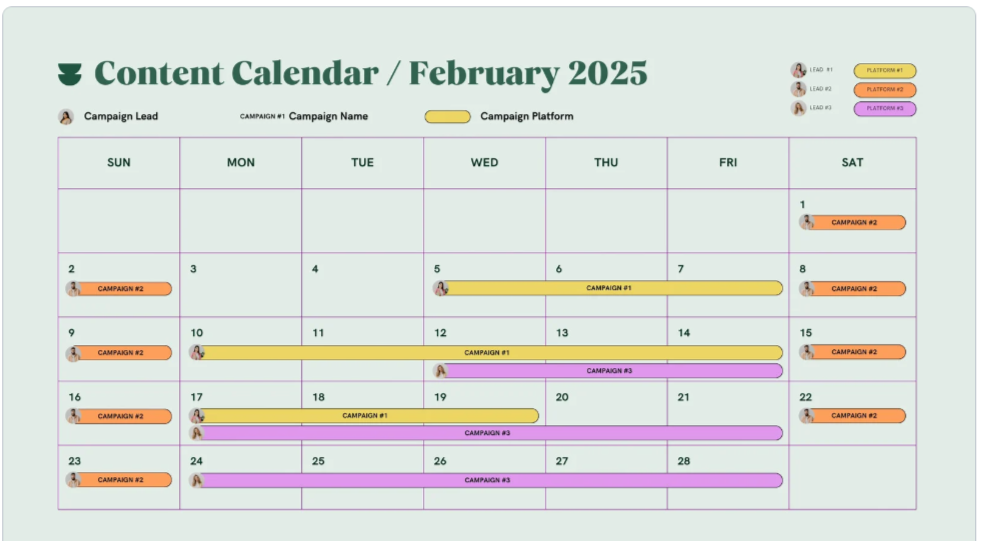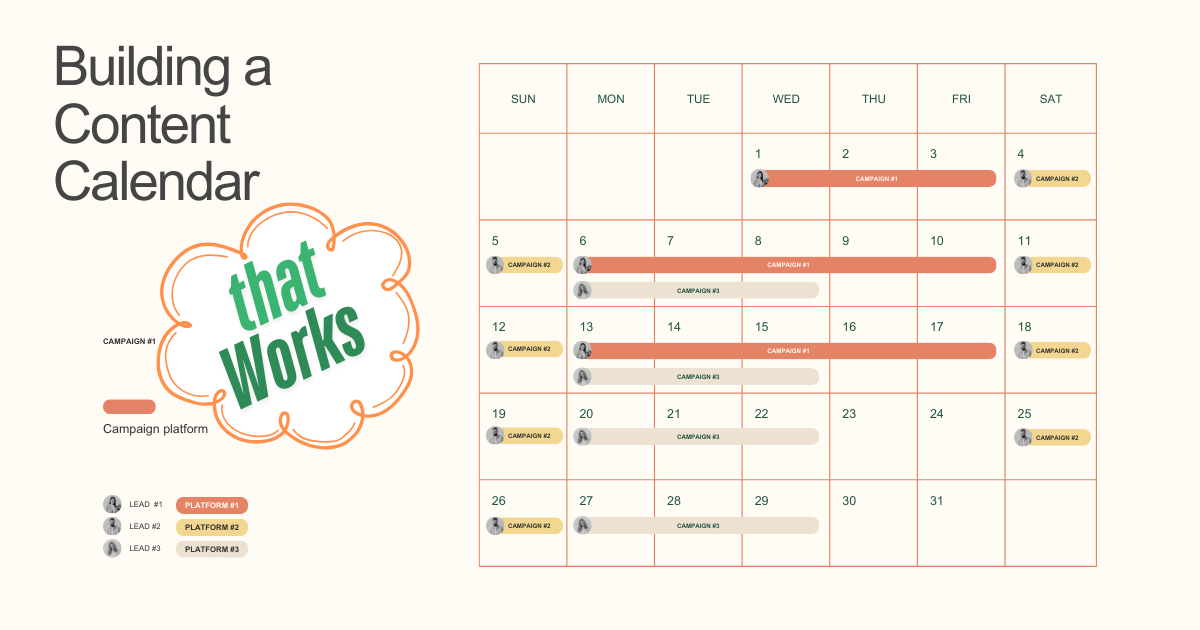Building a content calendar may sound a bit mundane, but trust me, it’s a game-changer for anyone in the content creation biz.
So, what exactly is a content calendar?
Simply put, it’s a schedule that outlines when and where you’ll publish upcoming content.
Whether you’re a solo blogger or part of a massive marketing team, a content calendar gives you a roadmap for content creation – and sharing.
Typically, there are two types of content calendars.
- A blog content calendar
- A social media content calendar
Depending on what you’re doing, you may use one or the other, or both.
For example, an independent blogger like me publishing here, I need both. When I work with clients creating blog content and they have a social media whizz handling their socials, I’ll only use the blog content calendar.
An easy way to handle both, I find, is with Google Sheets. Have one for your blog content and add another Sheet for socials. If all you’re doing is fairly basic, Canva templates are good enough.
 Personally, I’m a fan of Google Sheets like this because as content marketing campaigns progress, there’s likely to be items shuffled, columns added, and notes to update about the metrics of each page.
Personally, I’m a fan of Google Sheets like this because as content marketing campaigns progress, there’s likely to be items shuffled, columns added, and notes to update about the metrics of each page.
The True Power Lies in the Planning: Not Any Tools
It doesn’t matter whether you use a fancy editorial calendar, a plugin on your website, a template from Trello, Hubspot, Smartsheet, or Clickup, it’s the content strategy and planning that makes it effective. A good resource to get a jump start is the Content Calendar Template from Backlinko.com. Create a copy in your Google account, and edit the sheet for the data you need.
The real magic happens when you start reaping the benefits of a well-oiled content plan.
Picture this:
You’re no longer scrambling at the last minute to whip something up. Instead, your calendar sets a clear path, helping you sync with deadlines and align with any marketing cycles or campaigns you’ve got going.
I can’t tell you the number of times I’ve been updating a clients website and realized on the week an update was due, something like, oh, it’s Valentine’s Day!
When I’ve worked in teams as the content writer along with social media managers, content calendars keep teams in sync. It prevents them posting seasonal content to socials while I’d be posting evergreen content to the blog.
Very unprofessional. Content calendars avoid that!
This alignment not only smooths out production but ensures everyone in the team is on the same page.
Consistency is the BIGGEST Gain from Content Calendars.
You do know that inconsistent posting can hurt engagement? If not, now you do. With a plan in place, your content lands on time, and if your audience knows you’re reliable, they’re more likely to stick around.
And here’s another thing.
A solid calendar helps you balance between different types of content, keeping your feed fresh and varied. It can prevent overloading on one type of content while neglecting others.
So, to sum it up, a content calendar isn’t just a schedule—it’s your content strategy headquarters, making sure you stay composed, consistent, and totally in tune with your goals.
Crafting an Effective Content Calendar
Creating a content calendar that’s truly effective starts with understanding your audience.
After all, they’re the ones you’re creating for.
- Dive into their interests, behaviors, and needs.
What gets them engaging and sharing? This kind of intel is gold when planning out your content.
- Next up is setting clear objectives.
These could be anything from boosting site traffic, growing your social media followers, or simply increasing brand awareness. Whatever the goal, having it front and center makes sure your content calendar is a tool that drives towards these targets every day.
- Use the Right Tool for the Job
Picking the right tools also makes a huge difference. Whether you go for a simple spreadsheet (my preference) or a snazzy digital platform, it’s all about what best suits your team and workflow. The right tool can streamline planning, allow for easy adjustments, and keep everything in one accessible place.
Content Calendars are More than a To-Do List!

It’s easy to fall into the trap of thinking you’re being productive by batching tasks.
… Doing your keyword research, coming up with blog post titles, assigning them to categories and setting due dates for publishing.
The actual creation process of your calendar involves outlining your content types, themes, and timelines (like remembering to factor for seasonal content).
Put simply, what kind of content are you producing, what’s it about, and when’s it dropping?
Make sure there’s some flexibility built-in too, so you can jump on trends or react to anything unexpected coming your way. To use an example, I have a category here for SEO so when a Google algorithm updates happens, that’d likely trend so I’d be better to pivot by jumping on what’s trending.
That little wiggle room can go a long way. A rigid plan might leave you stuck if sudden opportunities pop up. Most CMS (Content Management Systems) let you schedule your blog posts so you’re better to work ahead of schedule. That way, you have content in the pipeline going live, and socials can be scheduled with tools like the Buffer app too.
While the calendar frames your strategy, leave some space for those moments you just can’t plan for.
The goal is not just to create a content calendar, but to craft one that’s both effective and adaptable, keeping you organized and ready to make the most of every opportunity.
Key Components of an Effective Content Calendar
When putting together a content calendar that actually works, it’s all about nailing the right components—think planning, scheduling, and coordination. Each of these plays a vital part in ensuring that your content aligns with your larger goals and keeps flowing seamlessly.
Planning is like your blueprint.
It’s where you dream big and think about what themes or topics you want to tackle. Having these ideas laid out well in advance can save you from those brain-frying moments when inspiration seems to vanish.
Next up is scheduling, the timeline hero.
This is where you decide the whens and wheres of posting content.
A clear schedule helps map out your workload and ensures deadlines aren’t missed. It’s not about being strict, but making sure everything gets its moment in the spotlight.
Coordination ties your content creation efforts together, making sure everyone involved knows their role. Whether it’s the writer, the designer, or the one handling social media… a well-coordinated calendar keeps everyone on the same wavelength and minimizes those nail-biting last-minute scrambles.
Another pro tip is integrating your editorial calendar with promotional plans. This means lining up content with upcoming campaigns or special events. Not only does this streamline efforts, but it maximizes impact, ensuring your audience sees the right message at the right time.
Each component might seem straightforward by itself, but together they create a smooth-running machine that’s built for success. That’s the beauty of it; everything works in harmony for a content calendar that doesn’t just exist but excels.
The Mechanics of How a Content Calendar Works
Think of your content calendar as a roadmap for your content journey. It’s not just about setting dates and topics—it’s about orchestrating how all the elements of your content strategy fit together.
You could be creating blog content on a Monday, repurposing for LinkedIn, X, and Facebook on Tuesday, doing video content on Wednesday, collaborating on Thursday for a guest blog or podcast episode, and by Friday, rounding everything up in a weekly newsletter.
Of course, that sort of thing would be ludicrous to try on your own, but within a business with a content marketing department, the calendar is the blueprint for campaign success. Each team member knows what’s happening, when, and where.
If you are on your own with marketing, the secret to a battle plan that doesn’t overwhelm is to focus on just one or two marketing strategies at a time.
Use your blog, email marketing, and one social media platform. Once you get some momentum going, switch things up by going back to your content calendar and repurposing the content for a different platform. LinkedIn, Medium, Substack, or soundbites on socials like Instagram, YouTube shorts, or TikTok.
Mapping out content types and themes lays the groundwork for variety and engagement.
Your content calendar only needs to address what channels you use. Your website is the business hub so that’s where to focus on content creation most. Optimizing for SEO, and using whichever social channels work best to build your audience. There’s no point focusing on LinkedIn for B2C, and likewise, there’s little to be gained creating TikTok content for B2B.
Only plan for content promotion that you have the time to work on, and is on a platform where your target audience actually visit, and engage on.
Templates can be incredibly helpful here. They give your planning some structure, ensuring nothing slips through the cracks. Having a go-to format for your calendar boosts efficiency and keeps you from reinventing the wheel every time you sit down to plan.
Integrating SEO strategies right into your calendar keeps your content on point. Consider keyword themes and search trends when planning to ensure that each piece not only resonates but also reaches the right people. It ensures that no piece of content is ever a solo act, but part of a bigger symphony.
Viewing your content calendar as a workflow from creation to publication helps you understand its full potential. Each stage, from brainstorming to clicking the publish button, is a step in your calendar. It’s about having a clear process that everyone involved understands and follows.
Maintaining Consistency to Maximize Your Contents Impact
Keeping your content calendar ticking requires a little diligence and a lot of enthusiasm.
Consistency comes from regular updates and making sure tasks don’t go undone. Mark routine check-ins on your calendar to tweak and update. This keeps everything aligned with any new goals or changes.
Getting everyone involved ensures the calendar isn’t just a document gathering digital dust—it’s a living entity. Assign responsibilities and make everyone aware of their roles.
With Google Sheets, you can use Data Validation Rules to insert drop down menus. Use that to assign categories for SEO, the names of contributors, and the status of each task – Done, in progress, drafted, edit, and published. From published, move to promotion and have a dropdown of hashtags ready to use to keep your campaign on point.
Regular reviews are essential. Not only for keeping your content calendar in good shape, but measuring results along the way. Seeing what content resonates most by adding in metrics from your Google Search Console and social analytics.
Reflection isn’t only for philosophers; it keeps your calendar primed, allowing you to evaluate what’s working and what could use a boost. Use these insights to make adjustments, whether that means shifting focus or introducing new types of content.
Tracking metrics is a big part of measuring the effectiveness of your content calendar. Think engagement rates, reach, or whatever metrics align with your initial goals. These numbers tell a story beyond just graphs and charts; they offer real feedback on your strategies.
A good content calendar evolves over time. It’s never about sticking rigidly to initial plans.
Instead, allow it to grow and change as you learn more about what works for your audience. Let your content calendar work its magic by being the dynamic and adaptive tool it’s meant to be.

